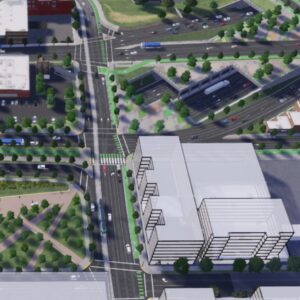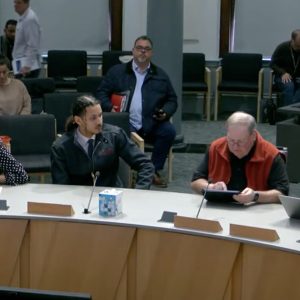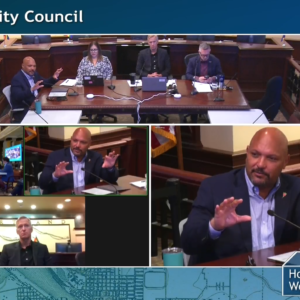
(Source: Independent Cover Assessment Report, 2021)
There’s been a lot of talk about the highway covers that are planned as part of the I-5 Rose Quarter project; but there hasn’t been much chance for the public to look under the hood and have a say in what might happen on top of them.
That will change this coming Monday, April 28th as the Oregon Department of Transportation (ODOT) and the Portland Bureau of Transportation (PBOT) co-host an event dubbed, Future I-5 Highway Cover: Lower Albina Planning Session.
These covers will play a crucial role not only in what type of neighborhood ultimately emerges on top of them, but also in how the bikeway network connects on key surface street routes.
The event will bring together staff from PBOT and ODOT, as well as the Bureau of Planning and Sustainability (BPS). They’ll have an interactive work session with members of ODOT’s Historic Albina Advisory Board (HAAB) and Community Oversight Advisory Committee (COAC), and some invited guests. The session will be facilitated by ZGF Architects, the firm that helped prepare the project’s Independent Cover Assessment in 2021. Here’s more about the event:
“This session continues the exploration of how potential highway cover uses relate to public spaces and the surrounding street network, building on visioning work previously done by Albina Vision Trust in collaboration with HAAB, COAC, and community stakeholders.”
Meeting organizers will allow public comment at the end of the work session, which will be held both online and in-person. The event will be held at New Song Church Community Center from 4:00 to 6:00 pm on Monday April 28th. More info here.





Thanks for reading.
BikePortland has served this community with independent community journalism since 2005. We rely on subscriptions from readers like you to survive. Your financial support is vital in keeping this valuable resource alive and well.
Please subscribe today to strengthen and expand our work.
I hope none of the cap’s surface area is dedicated to on-street parking. Given the estimated cost of the cap and proposed size, that would amount to spending over $1 million per parking space. I have heard the AVT folks talk about how surface parking is a bad land use, so I hope that comes through when all is said and done.
Why do you hate “balanced streets?”
/sarcasm
boondoggle –
noun
verb
This will be some of the most polluted real estate in Portland. I can’t imagine spending any amount of time here, much less living or working. Fine particulate pollution is extremely unhealthy.
Fortunately, as our vehicle fleet electrifies (especially trucks and other diesel vehicles), urban particulate pollution should fall significantly.
There is no evidence that BEV trucks are going to be widely adopted any time soon. Heavy BEV truck sales are a rounding error at this point, and we have so many unresolved barriers to mass adoption:
https://artofprocurement.com/blog/supply-examining-the-practicality-of-the-ev-truck-mandate
The future is so uncertain, that I don’t think it is reasonable to discount pollution concerns for massive freeway projects like this one.
It is also true that electric trucks will almost certainly be adopted at some point. It’s not like any of this is going to matter tomorrow — people promenading on I-5 lids is still quite a ways off.
The important thing (to me, at least) is that the trajectory is clear, plausible, and inevitable.
And even new diesel trucks are significantly cleaner than the ones they replace, and since long-haul trucks passing through CA will have to be particularly clean, I-5 get some spillover benefit from that even if Oregon Democrats surrender on their clean air commitments.
I also have bad news: a Swiss study calculated that 90% of environmental microplastics come from tires and that is not counting microparticles from asphalt wear.
On the contrary, I view that as good news. If 90% of microplastic pollution comes from a single source, that’s much easier to address than if it came from 90 different sources each requiring a different solution.
And 90% is a number that will attract much more attention and regulation than 1% or 2% would.
I have bad news for you:
https://pubmed.ncbi.nlm.nih.gov/35760182/
TLDR: EVs aren’t necessarily better on particulate pollution because most of it comes from tire wear, brake wear, and road surface wear. While EVs avoid tailpipe emissions, their added weight makes them worse in every other category of particulates.
For all their upsides, EVs are not going to save us from being steeped in harmful levels of urban particulate pollution. The only thing that’ll do that is having fewer cars on the road (and making the ones that are there as light as possible).
Gasoline engines with catalytic converters emit relatively few particulates (which is why I focused my comment on diesel trucks), but EVs are still cleaner (as stated by abstract of your article*). EVs with regenerative braking also emit way less brake dust than regular vehicles, though tire dust is still a problem.
EVs don’t have to “save us” to be a hugely beneficial step forward, nor need they be the sole solution to everything or anything. Lighter vehicles (as you say) will help. Driving less will help. Eliminating diesel TriMet buses will help. Cleaning up diesel trains, garbage trucks, and the myriad point-sources throughout the city will help.
And convincing people to stop using their fireplaces and heating with wood will help, a lot.
In short, your article isn’t bad news at all.
*”When secondary PM emissions were included, the EF was always significantly lower for the EV than ICEVs”
I generally concur with Chris I below, but I think it’s also worth pointing out that lots of particulate pollution from driving is from tires, not just from diesel. I would have to read a lot more about how traffic dynamics affect wear and tear on tires to say with any certainty, but I would guess that this project will make tire particulate pollution worse on the grounds of there being more vehicles. And that is something a BEV truck would make even worse, since trucks are very heavy
Higher speeds tend to increase tread wear via heat transfer. Particulate matter tends to be the majority of pollution from cars regardless of engine type. I think the number is around 2000x more particulate matter than engine pollution, but that also depends on whether the car is old enough to be exempt from DEQ (in OR that is 25 years I think). So in general the adoption of electric cars will have a negligible effect on particulate pollution.
Do you really think that electric trucks will emit more particulates than diesel trucks? Diesel engines, especially older ones, emit a LOT of particulates. And diesel trucks are also heavy.
And why will the RQ project generate more trucking activity?
And here’s some reading material on the topic of EVs and urban pollution, that addresses all of your points.
https://www.transportenvironment.org/articles/electric-vehicles-are-far-better-than-combustion-engine-cars-when-it-comes-to-air-pollution-heres-why
Will it be? Everything I’ve seen has said caps reduce reduce pollution near the freeway so it seems like the pollution on top of the cap wouldn’t be anymore than the properties adjacent to it. That mean properties next to uncovered freeways would be more polluted than the properties on the cap.
Have you been to Boston and checked out the lid over the Big Dig? It’s pretty amazing. Although granted Boston is a lot cleaner than Portland.
How much do the real estate developers in the AVT stand to make from all this? How much does Loretta Smith and her associates stand to profit from the freeway expansion project?
Probably some, but non profit affordable housing developers aren’t really known for being flush with cash (at least not relative to the for profit side of things).
An aspect of the project which isn’t really being talked about right this second, but which is probably directly relevant is how much the caps can hold. This a massive contributor to cost of the project, and if we decide to go with less buildable caps with a park focus there’s still the chance to do a lot of great redevelopment in Lower Albina since the area should be more practical for living in with lower freeway pollution and easier access across the freeway. That’s an aspect where – assuming AVT gets the deed to the cap-land – they directly profit from this whole scheme. But even that profit is probably heavily limited by the general plans and promises of AVT (without which, the entire scheme falls apart).
I like the idea of a bold future for Lower Albina, but to some extent money is an object here and it would probably be better to compromise on the buildings on the cap in exchange for lowering the costs for the project writ large. Redeveloping the coliseum + nearby parking and the PPS building gives plenty of room for genuinely revitalizing Lower Albina while being more attractive to the various public agencies that have to pay for this stuff. If it costs $500M to build the caps so they can support a 5 story building, why not just spend that money on directly acquiring parking lots nearby for redevelopment instead?
Exactly, if the point is to revitalize the neighborhood, how much real estate can be purchased for $500m. Nextportland seems to be out of date, so I’m not sure what is currently in the pipeline to be developed, but here are some examples from the area:
20 Hancock: market value 9m
55 Bway: market value ~2m
307 Bway: market value ~1m
AVT’s seemingly all-in to commit to the freeway expansion in order to get the caps built. But a sizable part of the neighborhood could be purchased for $500m. Judging by ODOT’s historical budgetary overrun (let’s say a very conservative minimum of 100%), the cost of the project will balloon, guaranteeing some level of cost mitigation for the caps. It’s a bizarre situation, entirely predictable, adding virtually no value to the neighborhood, quantitatively or livability-wise.
Can we just find the money for AVT from the state/city budget so they will bail on this awful project?
The PPS building (501 N Dixon) has a transfer agreement with AVT where AVT is building/sourcing a new equivalent HQ in exchange for the building (which would need $200M in seismic retrofits anyways). Not sure on the timeline or total cost – this interview says something like $70M for a new PPS building. Plus the cost to demo the current building and get it off the ground must be quite a bit more, but couldn’t find an estimate.
In some ways, AVT seeking to get buildable caps is natural – since they are the primary direct benefactors. I don’t mean to minimize the vision of building on the caps – which is admirable – but yeah it feels like the opportunity cost is fairly high. That said, since ODOT/FHWA are on the hook for most of it, it only matters from the perspective of having a solvent state transportation agency.
From my perspective as just some guy, pivoting to parks on the caps + promises of more land being given for redevelopment makes sense, but is probably extremely difficult to broker. I think a big part of the appeal of buildable caps is that it’s just a lot easier to manage a project with a carte blanche, rather than a more politically contentious and litigious process of doing eminent domain.
I remember attending a similar freeway capping event for I-405 in the early 2000s with lots of expensive pie-in-the-sky suggestions. Someone there suggested installing turbine generators on top of the caps to turn the resulting air pollution into power.
Metro Seattle has several freeway caps, including the long one over I-90 on Mercer Island that has a soccer field on it. I saw several recently in Atlanta.
There’s pie in the sky, and then there’s magical thinking. What, exactly, would turn the turbines?
Concentrated hot air from the fumes. There was a funnel mechanism in the design based on the fans that normally operate in tunnels to keep air circulating – instead of forcing air out at the ends, the air would instead be funneled up to the turbine vents. And I agree, the idea was absurd, but so was the whole notion that ODOT was going to pay for capping any of I-405.
Where did you see freeway caps in Atlanta? They first came up when I was in college (ca. 2003) and only just on April 22nd did “The Stitch” get funding from the ATL City Council.
Now show the view from the Moda Center looking east.
This is such an obvious con job. The funding isn’t there even for the stated cost, let alone the actual cost, which inevitably will be at least twice what they’re currently claiming. All ODOT wants to do is pave everything, it’s ridiculous. I wrote my city counselors about this and got no response.
Yup. With estimates from any governmental agency in Oregon, make sure to double or triple the initial guess.
Citation please
All of this feels like an excuse to expand the freeways more 🙁
How is it guaranteed that this will be a renaissance of black businesses, and if it is possible to attain this with a 2 billion dollar multi-year complicated environmentally destructive mega project, why can’t it be done now or 5 years ago?
I would love to see this happen, but I am interested to see the details of the plan.
Open Question: Is it desirable or even legal for a taxpayer funded project to prioritize the “renaissance” of businesses whose owners are a specific skin color? Something to ponder….
https://www.oregonlive.com/business/2021/10/oregon-settles-second-lawsuit-over-pandemic-aid-earmarked-for-black-oregonians.html
I believe it is highly desirable, and it is about much more than “skin color.”
However, if that is the stated goal, at this point of planning, it should be explicitly described and tested how this will actually happen. In fact, this element is more important than the small area that will become available for buildings. In the Lower Albina area, there are already spaces that can be developed that aren’t being developed. What are the current barriers to black-owned businesses? Is it really that there are culturally black businesses and public centers that are not possible to support without a freeway cap attached to a highway megaproject.
“I believe it is highly desirable, and it is about much more than “skin color.”“
I still don’t understand the professed desirability of restoring a displaced ethnic group’s location of only one community as if the world does not constantly change. If the goal is to restore land, wealth and ownership to a displaced population why not start with the original native groups who were brutally removed from theirs?
https://nativetribe.info/portland-oregon-native-american-tribes-history-culture-2/
Why cherry pick from recent history and ignore what happened to the other minority groups during the same time frame in Portland when the original displacement and subjugation of the locals could could easily be described as genocide or at least an attempted genocide?
Where is their restored lands? Or is this a case of the ultimate NIMBY?
I would like to hear you expound on how it is “much more than skin color” and how it is this one group that all this money, effort and environment destruction should be focused on. I am not trying for a gotcha, I’m curious on your thoughts.
Despite the ignorant claims of some of the comments at the tail end of this thread, the black community in NE Portland is still very much present and an important part of the city. It benefits all of us to strengthen minority communities and create spaces and opportunities for them to thrive. It is a positive for everyone, and should take priority over highway mega-projects. This is true for many communities/ cultures in Portland.
The argument that if we should do nothing for the black community, because native Americans were also harmed is specious, because you are not seriously promoting a plan to create a space for native communities or culture. You seem to be using it as an argument to do nothing for minority communities that are actively engaged in trying to persevere and progress.
I’m not promoting a plan to create space for the displaced Natives, Italians, Jews, poor anglos or any other POC that Portland has brutalized over the decades.
The question I asked is why and how pick one group to elevate above the others for restitution when that restitution is a freeway widening project (I don’t believe the caps will ever be built) that will only benefit a literal few of the targeted group through ODOT contracts.
I am not a big believer in segregation so spending a ludicrous amount of money to widen the interstate (with all the toxic problems that entail’s) for the stated reason (that won’t actually be fulfilled because the caps won’t be built) of providing for a specified ethnic group’s segregation doesn’t make much sense to me.
I was hoping someone with a different viewpoint such as you (or anyone at this point) would be able to put forth a compelling reason why it was a good idea,
Since this project seems to be fueled by DEI objectives, I wonder if the federal funding will be eliminated?
I’m afraid anyone opposing this project publicly will be charged with racism. It’s the commonly used cudgel in progressive Portland to push through dubious projects.
The historical Albina neighborhood is never coming back.
But Albina Vision Trust will sure spend a lot of tax dollars trying…..